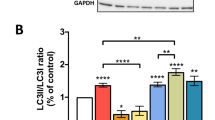Abstract.
Acquired immunodeficiency syndrome (AIDS) is a disease caused by infection with the human immunodeficiency virus (HIV). Although drug therapy for AIDS is available, problems such as side effects associated with drug therapy and the appearance of resistant HIV strains have arisen. Therefore, therapies based on new principles other than drug treatment are required. In the present study, the effect of electrical stimulation on HIV-1LAI chronically infected HeLa (P6 HeLa/HIV-1LAI) cells cultured on an electrode surface was examined. The results indicated that sensitivity to electrical stimulation was much higher in P6 HeLa/HIV-1LAI cells than in uninfected p6 HeLa cells. When electrical stimulation was applied at 1.0 V (vs. Ag/AgCl) for 20 min, the proportion of damage to cell membrane among P6 HeLa/HIV-1LAI cells, as evaluated by Trypan blue staining, was approximately 4 times higher than that for uninfected P6 HeLa cells. Furthermore, in comparison with uninfected P6 HeLa cells, the proliferation of P6 HeLa/HIV-1LAI cells was significantly suppressed after electrical stimulation. This technique was proven to selectively kill P6 HeLa/HIV-1LAI cells, when compared with uninfected control cells.




Similar content being viewed by others
References
Aizawa M, Koyama S, Kimura K, Haruyama T, Yanagida Y, Kobatake E (1999) Electrically stimulated modulation of cellular function in proliferation, differentiation, and gene expression. Electrochemistry 67:118–125
Berg H, Augsten K, Bauer E, Forster W, Jacob H-E, Muhlig P, Weber H (1984) Possibilities of cell fusion and transformation by electrostimulation. Bioelectrochem Bioenerg 12:119–133
Gallo RC, Salahuddin SZ, Popovic M, Shearer GM, Kaplan M, Haynes BF, Palker TJ, Redfield R, Oleske J, Safai B, White G, Foster P, Markham PD (1984) Frequent detection and isolation of cytopathic retroviruses (HTLV-III) from patients with AIDS and at risk for AIDS. Science 224:500–503
Greenberg ME, Greene LA, Ziff EB (1985) Nerve growth factor and epidermal growth factor induce rapid transient changes in proto-oncogene transcription in PC12 cells. J Biol Chem 260:14101−14110
Kojima J, Shinohara H, Ikariyama Y, Aizawa M, Nagaike K, Morioka S (1991) Electrically controlled proliferation of human carcinoma cells cultured on the surface of an electrode. J Biotechnol 18:129–140
Koyama S, Haruyama T, Kobatake E, Aizawa M (1997) Electrically induced NGF production by astroglial cells. Nat Biotechnol 15:164–166
Kurischiko A, Berg H (1986) Electrofusion of rat and mouse blastomeres. Bioelectrochem Bioenerg 15:513–519
Mie M, Ohgushi H, Haruyama T, Kobatake E, Aizawa M (1996) Electrically enhanced osteogenic differentiation of rat bone marrow stromal stem cells. Cell Eng 1:153–158
Morizono K, Harada S (1998) Human immunodeficiency virus type 1 (HIV-1) infection and transcytosis activity of a HIV-1 susceptible clone from HeLa cell. Microbiol Immunol 42:313–320
Motohashi N, Shinohara H, Furukawa S, Aizawa M (1996) Electrically controlled differentiation of PC12 cells on electrode surface. Cell Eng 1:70–74
Palella FJ, Delaney KM, Moorman AC, Loveless MO, Fuhrer J, Satten GA, Aschman DJ, Holmberg SD (1998) Declining morbidity and mortality among patients with advanced human immunodeficiency virus infection. N Engl J Med 338:853–860
Powell KT, Derrick EG, Weaver JC (1986) A quantitative theory of reversible electrical breakdown in bilayer membranes. Bioelectrochem Bioenerg 15:243–255
Tominaga M, Kumagai T, Takita S, Taniguchi I (1993) Effect of surface hydrophilicity of an indium oxide electrode on direct electron transfer of myoglobins. Chem Lett 1771–1774
Valk M van der, Bisschop PH, Romijn JA, Ackermans MT, Lange JMA, Endert E, Reiss P, Sauerwein HP (2001) Lipodystrophy in HIV-1-positive patients is associated with insulin resistance in multiple metabolic pathways. AIDS 15:2093–2100
Yaoita M, Aizawa M, Ikariyama Y (1989) Electrically regulated cellular morphological and cytoskeletal changes on an optically transparent electrode. Exp Cell Biol 57:43–51
Zimmermann U (1982) Electric field-mediated fusion and related electrical phenomena. Biochim Biophys Acta 694:227–277
Acknowledgements.
We gratefully acknowledge Ms. Y. Turu, Ms. A. Hara, Ms. S. Douki, and Ms. S. Mizukami of Kumamoto University College of Medical Science for their technical support.
Author information
Authors and Affiliations
Corresponding author
Rights and permissions
About this article
Cite this article
Tominaga, M., Kumagai, E. & Harada, S. Effect of electrical stimulation on HIV-1-infected HeLa cells cultured on an electrode surface. Appl Microbiol Biotechnol 61, 447–450 (2003). https://doi.org/10.1007/s00253-003-1225-7
Received:
Revised:
Accepted:
Published:
Issue Date:
DOI: https://doi.org/10.1007/s00253-003-1225-7




